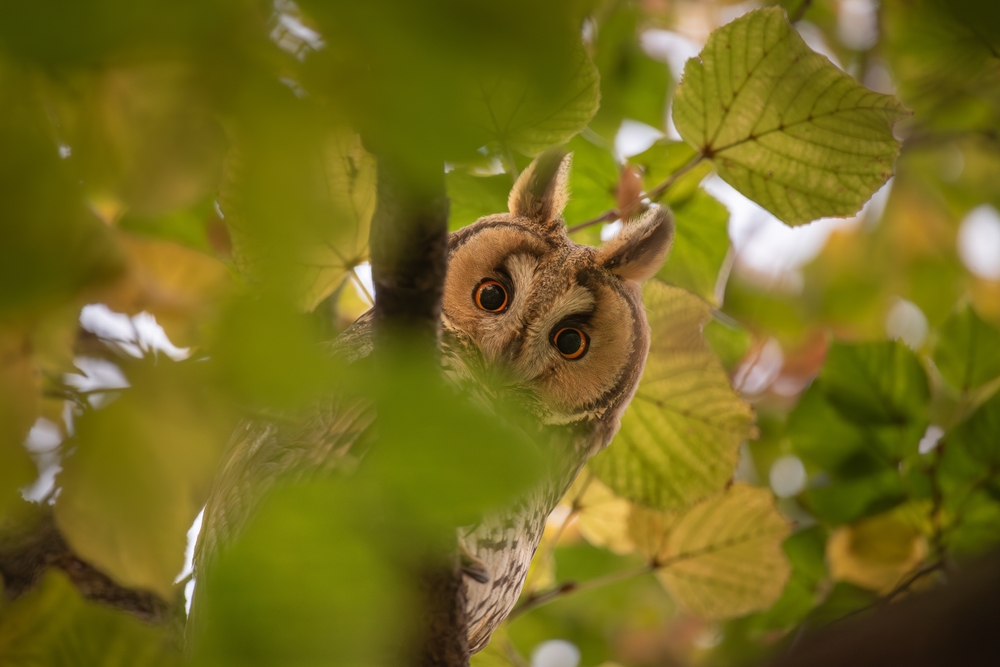Ahh, the world of glowing animals. From wombats and platypuses to puffins and bats, many animals of planet Earth can rustle up not only their typical colors but a few hidden tricks in their feathers and fur that only show up under certain conditions. Joining the ranks are long-eared owls (Asio otus), which have been found to have feathers that glow pink under ultraviolet light (UV).
Researchers collected feathers from the owls during the spring migration season in 2020 at Whitefish Point Bird Observatory in Paradise, Michigan. In total, 99 feathers were sampled. During the sampling process, the owls were also sexed so the team could compare the UV features of their feathers against known factors in long-eared owls. Females are significantly larger than the males and also have darker feathers, particularly on the underwing. Therefore, the team wanted to find out whether body size and/or sex had an influence on the glowing feathers.
In owls, the fluorescent pigments are found on the barbs of body feathers that are on the underside of their wings. This keeps the feathers out of the sunlight and preserves the fluorescent pigments, which can begin to degrade with exposure. These photosensitive pigments are known as porphyrins and are what causes the feather to glow. In particular, the owls have two porphyrins that are called coproporphyrin III and protoporphyrin IX.
“We are only beginning to describe fluorescent pigments in birds and other vertebrates,” said Emily Griffith, a PhD candidate in the Biodiversity, Earth & Environmental Science department at Drexel University and study lead author, in a statement. “Although describing what species they are present in is important, in order to understand what their function is we need to also describe how they vary within a species like the long-eared owl.”

“The normal light spectrum is for losers…” – long-eared owl (probably).
Image Credit: Artem Tkachuk/Shutterstock
The team found that birds that were older and female had a higher abundance of fluorescent pigments within their feathers. They also found that younger birds had more fluorescent pigments if they were heavier, but this only applied to juvenile birds. These conclusions match what the team expected based on the owls’ pigments seen in the visible light spectrum.
“Our study shows that female long-eared owls have a much higher concentration of these pigments in their feathers, challenging a common misconception that colorful plumage is a ‘male’ trait,” said Griffith. “Moreover, this trait doesn’t follow a strict binary – the amount of fluorescent pigments in these owls exists on a spectrum where the amount of pigment is related to size, age, and sex all together.”
The researchers think that the fluorescent feathers may be a visual signal that can be used in sexual selection. Males perform courtship dances that show off the underside of their wings. Previous work has found a relationship between food abundance and fluorescent pigments in Eurasian eagle owls (Bubo bubo), suggesting that it could show female owls the healthiest, strongest males.
However, the team also has another theory: that the fluorescence pigments can limit radiative heat loss in females while they are nesting. This idea would help explain the differences in fluorescent pigment abundance between the males and females.
“So little is known about fluorescent pigments in bird feathers and owls aren’t the only ones with fluorescent pigments,” said Griffith. “So, it’s a really exciting time to be interested in studying bird plumage.”
The paper is published in The Wilson Journal of Ornithology.
Source Link: Pretty In Pink: Long-Eared Owls Found To Fluoresce Under UV Light Join Glowing Animal Brigade